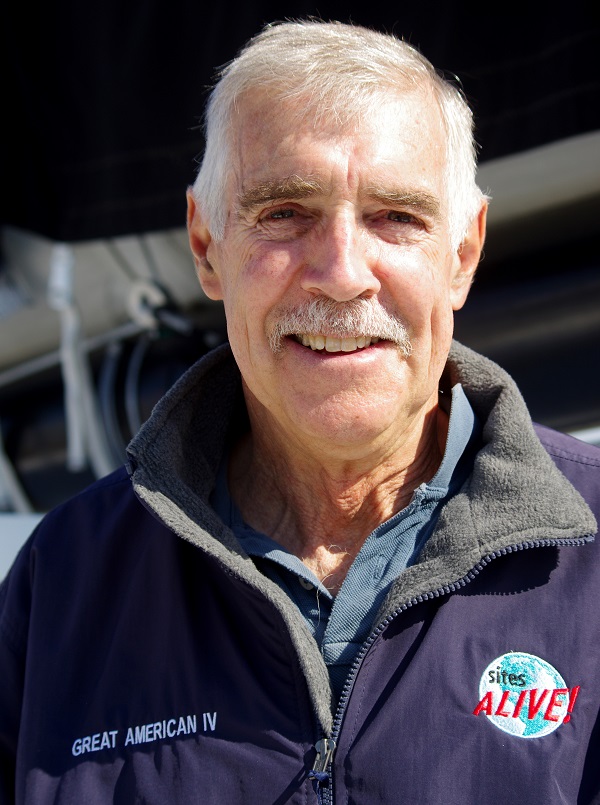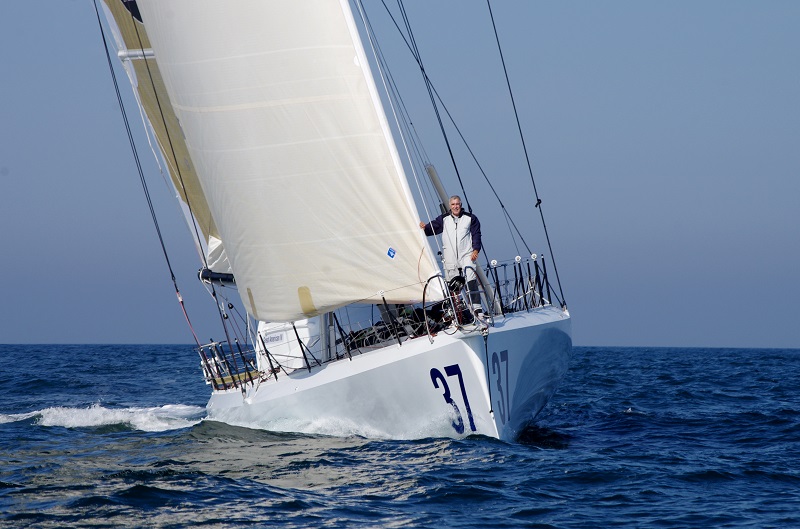By Joe Cooper
 Fall appears to finally be upon us. As I write, the temperature is not in the 80s, the sky is overcast and the trees are shedding their leaves, finally. I am still buzzing after sailing the foiling cats at the Red Bull Foiling Generation ‘go for a sail’ event last Monday. That was a great way to blast out of this season. But what’s next? What are we all doing for the next three months or so until we can start thinking about 2017 sailing?
Fall appears to finally be upon us. As I write, the temperature is not in the 80s, the sky is overcast and the trees are shedding their leaves, finally. I am still buzzing after sailing the foiling cats at the Red Bull Foiling Generation ‘go for a sail’ event last Monday. That was a great way to blast out of this season. But what’s next? What are we all doing for the next three months or so until we can start thinking about 2017 sailing?
A professional educator, a sailor and an adventurer, Rich Wilson founded sitesALIVE! In 1990 to engage students in science, geography, math and history by connecting them to live, real world adventures. © B. Gergaud/courtesy of sitesalive.com
Halloween, cleaning up after Halloween, Veterans Day…really, go and check out Warrior Sailing. Think you’re having a bad hair day? Honestly, this is a fantastic, real way to really thank these men and women for their service. Volunteer, or add them to the list of great charities doing fantastic work to whom you will donate some of your bonus this year.
Then there is Thanksgiving, shopping, Christmas present wrapping, New Year’s Eve and related hangover recovery, skiing, and maybe Key West for some. It’s going to be a pretty normal kind of life for those of us who are not Warrior Sailors or asthmatics, right?
On November 6, 2016, 29 sailors from 10 countries get underway in what really is the world’s toughest sailing race. It is a race that makes all others pale in comparison, and pretty much any other ‘sporting’ activity too. It makes reality shows look childish. The experiences are not manufactured and there’s no film crew shooting your manufactured stress. More people have been in space and on Everest than have participated in the Vendée Globe. Fewer still have finished the Vendée Globe.
In the U.S., for those who recognize the name, the Vendée likely is regarded as one of those loony French, anti-social, single-handed races. Well, two out of three. It is French and it is single-handed. A refresher: The Vendée Globe is non-stop, around the globe, without assistance, single-handed in 60-foot fire-breathing monohulls, the top half dozen of which are new foiling boats. This remarkable race is covered on the nightly TV news, 100,000 people trek to Les Sables-d’Olonne for the start, and the rest of the media stats are mind boggling for a loony sailboat race.
As for the crazy part of it, well it is a risk, like any other sailing or, frankly, life activity and yes, this risk is higher than sailing to Bermuda or transatlantic. With higher risk comes higher planning and preparation, and preparation is, or should be, a staple of sailors going anywhere at anytime on anything for any reason.
Several of the French entries are sponsored, and have been in some cases for over 20 years, by multi-billion Euro, publicly traded French companies across the business spectrum. The French version of Home Depot, a couple huge banks, commercial real estate firms, major food suppliers and so on. These firms use sailing as an aggressive part of their marketing and branding programs. The fact that the Vendée is hard, requires a special kind of mentality and approach, has many technical requirements and related difficulties that need to be managed, sometimes alone in very difficult circumstances, needs a team and leaders to make it all happen…well, these are the attributes companies say they want in their employees. At the other end of the spectrum, there are the largely or completely self-funded programs, one of which is American.
A native of Boston, MA, Rich Wilson is unique in this edition due to his age, his physical condition, and his goal. This is his second Vendée Globe to be sure, but there are three other entrants embarking on their second and five skippers doing their fourth.

Thousands of students are tracking the progress of Rich Wilson’s IMOCA Open 60 Great American IV in the Vendée Globe via his non-profit educational organization sitesALIVE! © B. Gergaud/courtesy of sitesalive.com
Rich’s funding comes largely from his educational program, sitesALIVE! It is a great program, and as you know I am very fond of anything that links sailing and kids. At 66, Rich is the oldest competitor in this edition. (The youngest is 23.) But beyond that, Rich is a lifelong asthma sufferer. For a three-month event that is one of the most physically straining possible, this is a remarkable piece of grit. Granted, it is not Warrior Sailing, or more accurately the conditions under which the warriors were in, he told me, that caused them to have need, or benefit from Warrior Sailing, but it requires all the same human traits that the damaged servicemen and women must now use to rebuild their lives as best as they can.
Rich is the most unlikely looking guy to be embarking on such a passage. He looks like a rather rumpled college professor. Soft spoken, self-effacing and definitely not macho looking, he is just about the last guy, simply looking at him, that you would expect to be tough as nails. As it turns out, his lifelong struggle with asthma has basically formed his life.
Unable to play with his mates in school as a kid made Rich something of an outsider, he told me. He was with me in the RIB last May when we went out to meet Joe Harris on his return from his lap around the Blue Marble, and while waiting we chatted about Rich’s background. In everything he has done, which is a lot, he has made it a point of character (my word) to not let the physicality of something stop him. With respect to long distance sailing and the planning for same, Rich has as much experience as any. This includes multiple transatlantic crossings, several half-globe passages, upside down off Cape Horn, and then getting flipped right way up again. A recorded first.
His training regimen for the physical parts of this race is mind-boggling. Swimming, running, bicycling, weights – The Full Monty, all done at about 70% of lung capacity. At age 66.
But I think his proudest returns are the exposure he gives to children and young adults about the world outside their constrained orbits. Started in 1990 using single sideband radio and printed newsletters for distribution, SitesAlive.com has completed 75 expeditions. These include the New York to San Francisco passage resulting in the capsize noted above, a second passage over the same track, breaking the record and not the boat, the PACT 95 America’s Cup syndicate with fellow math-head John Marshall, the 1993/4 Whitbread, and on for another 71 adventures.
SitesALIVE! distributes a K-12 teacher guide that tracks the boat and incorporates everything school kids need to learn. Sailing does, after all, use about 12 hard scientific disciplines and a few more soft ones, such as how to think, and how keep your wits about you when you are alone in the Southern Ocean, at 0230, it is 33 degrees inside the cabin (and out), it’s blowing 40 and forecast to get to 55, and you have to suit up to go on deck to reduce sail. Self-will, the ability to do what your brain and heart is saying – maybe screaming – DON’T, is a subject about which very little is spoken of, in schools or outside them.
One thinks about the horrible conditions under which our military, any military in fact, must operate; the force of will it must take to keep going. Even if they won’t talk about it, I bet there are a lot of grandfathers out there that would speak to that if they could. And no, I am not equating what the military does with what Rich is doing. Rich is, after all, only doing a loony French solo race.
Australian born, Joe ‘Coop’ Cooper stayed in the US after the 1980 America’s Cup where he was the boat captain and sailed as Grinder/Sewer-man on Australia. His whole career has focused on sailing, especially the short-handed aspects of it. He lives in Middletown, RI where he coaches, consults and writes on his blog, joecoopersailing.com, when not paying attention to his wife, teenage son, dog, two cats and several, mainly small, boats.




